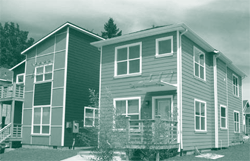October 2008
In this Issue
Healthier Homes, Healthier Children
Local Transitional Housing Effort Wins Award
A New Formula for Greening Neighborhoods
In the Garden... On the Roof!
In the next issue of ResearchWorks
A New Formula for Greening Neighborhoods
An initiative has been launched wherein 238 Leadership in Energy and Environmental Design Neighborhood Development (LEED-ND) pilot projects are being carried out in 39 states and 6 countries. Although diverse in size, design, and setting (rural, urban, and suburban), they share the objective of pioneering a national standard for neighborhoods that focuses on smart growth, New Urbanism, and eco-efficient design. Three LEED-ND projects that exemplify these principles are the Storrs Center in Mansfield, Connecticut; Thornton Place in Seattle, Washington; and Helensview in Portland, Oregon.
The Storrs Center in Mansfield, which abuts the University of Connecticut, will feature 47-plus acres of residential and mixed-use components, including a new town center and a market square. In addition to retail, restaurant, commercial, and residential uses, the development will include civic and community spaces. About 30 acres will be placed in a conservation set-aside.
Thornton Place is a 6-acre, mixed-use development with 50,000 square feet of retail space, a 14-screen movie theatre, 109 condominiums, and 278 apartments. The developer's goal is to transform an auto-centric shopping magnet into a vibrant, livable, pedestrian-friendly neighborhood with entertainment, housing, public art, walking paths, and nearly three acres of green space around a new waterway. Rental apartments for older adults will also be developed at the site.
 Helensview is an affordable, single-family development of 41 homes and 12 condominiums that cost between $196,000 and $248,000 — significantly less than the median home price in both the surrounding county and the Portland metropolitan area ($286,000 and $339,900, respectively). The homes, which are close to public transit, feature energy-efficient technologies, granite counters, gas fireplaces, and home warranties. The development also offers a children's play area. Qualified homebuyers have access to closing cost assistance and tax abatements.
Helensview is an affordable, single-family development of 41 homes and 12 condominiums that cost between $196,000 and $248,000 — significantly less than the median home price in both the surrounding county and the Portland metropolitan area ($286,000 and $339,900, respectively). The homes, which are close to public transit, feature energy-efficient technologies, granite counters, gas fireplaces, and home warranties. The development also offers a children's play area. Qualified homebuyers have access to closing cost assistance and tax abatements.
Officially still in the pilot stage, LEED-ND is a project of the U.S. Green Building Council (USGBC), the Natural Resources Defense Council, and the Congress for the New Urbanism. LEED-ND builds on USGBC's experience with developing green certification systems for commercial buildings, schools, and homes. With LEED-ND, green certification enters a new era of attempting to measure not just the green aspects of individual buildings, but also the green benefits for neighborhoods. When fully vetted and voted on by USGBC membership in mid-2009, LEED-ND will become the first-ever national set of standards for neighborhood location and design based on the combined principles of smart growth, New Urbanism, and green building.
According to USGBC's report Pilot Version: LEED for Neighborhood Development Rating System, the LEED-ND rating system is designed to be flexible, a few mandatory requirements plus many optional items that can earn credits. A minimum of 49 points is required for certification; higher scores will gain silver, gold, or platinum LEED-ND certification.
Elements of the rating system include the following:
- Location-related goals (30 possible points). Reduce dependence on cars; encourage walking and bicycle use. Place homes close to schools and jobs. Redevelop brownfields. Conserve agricultural land, wetlands, and proximate bodies of water. Preserve imperiled species and ecological communities. Provide for restoration and conservation of habitat or wetlands, protect steep slopes, and avoid floodplains.
- Neighborhood pattern and design goals (39 possible points). Promote livability and transportation efficiency. Provide walkable streets and sidewalks, as well as safe and comfortable transit facilities. Design for diversity of land uses and compact development (for example, seven dwellings per acre of residential land). Include affordable housing (both rental and sale units). Reduce the parking footprint to no more than 20 percent of total development; include carpool spaces and bicycle parking. Situate dwellings close to public spaces and sports facilities, providing handicapped accessibility. Promote community gardens and farmers markets. Encourage community involvement in project planning.
- Green construction and technology (31 possible points). Plan energy-efficient buildings and infrastructure using green building practices. Include adaptive and historic structure reuse. Strive to minimize site disturbance (dust, sedimentation, and topsoil loss); reduce water use; and recycle content in infrastructure. Manage construction waste and stormwater runoff. Encourage design that takes advantage of solar orientation and reduces heat island effects. Incorporate onsite energy generation and renewable energy sources. Encourage water reuse, district heating, and cooling. Reduce light pollution.
- Innovation and design process (6 possible points). This part of the rating system invites participants to receive additional points for exceptional performance in the above categories or innovative performance in categories that are unspecified but consistent with LEED-ND objectives.
Although still in the pilot stage, the LEED-ND rating system is on its way to promoting diverse and environmentally friendly neighborhoods. In the meantime, USGBC is tracking the questions, concerns, and progress of these pilot projects in preparation for the program's full launch next year.1 Those interested in obtaining additional information on the LEED-ND rating system can find it at www.usgbc.org/DisplayPage.aspx?CMSPageID=148.
1. Stefanie Young, The New Frontier of LEED®: Piloting LEED for Neighborhood Development. Presented at the Fifth Annual Greening the Heartland Conference, St. Louis, Missouri, June 2008, www.greeningtheheartland.org/Presenters08/4website/Young_GC1-B.pdf.

